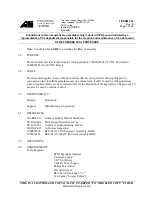
L-ACOUSTICS XT Manual V1.1
2/11/2003
33
600 Hz (due to floor reflections). MONITOR presets compensate for these two half-space loading
effects and provide a frequency response curve that is nominally flat.
Subjectively, low frequency half-space loading compensation provides a high degree of “warmth and
body” to vocals, while the flat high frequency response that has been engineered for the MONITOR
preset provides excellent fidelity and feedback resistance. Since the overall MONITOR response
curve is nominally flat, simple adjustments to the relative output gains between high and low channels
allow the monitor engineer to quickly adjust the overall response contour to obtain more vocal
presence (as desired). Power response is very even and stable due to the axi-symmetric directivity of
the coaxial component configuration and this results in improved coverage and feedback resistance.
When using XT enclosures in pairs for floor monitoring, the same principles apply as for overhead or
distributed front fill systems, i.e., the optimum spacing between floor monitors will depend on the
coverage angle of the enclosure (90 degrees for 112XT, 80 degrees for 115XT) and the throw
distance to the performing artist (which is determined by the floor monitor angle with respect to
vertical and the artist’s height). Center-to-center overlap will provide the most uniform coverage and
as a guideline, nominal monitor distance plus monitor separation is tabulated below in Table 11.
Table 11: Nominal floor monitor distance (to performer) and monitor separation versus performer height
112XT (45 deg angle wrt vertical, 90 deg coverage)
PERFORMER HEIGHT
Performer <-> Monitor Monitor <-> Monitor
(cm)
(ft / in)
(cm)
(ft / in)
(cm)
(ft / in)
160
5 ft
3 in
160
5 ft
3 in
160
5 ft
3 in
165
5 ft
5 in
165
5 ft
5 in
165
5 ft
5 in
170
5 ft
7 in
170
5 ft
7 in
170
5 ft
7 in
175
5 ft
9 in
175
5 ft
9 in
175
5 ft
9 in
180
5 ft
11 in
180
5 ft
11 in
180
5 ft
11 in
185
6 ft
1 in
185
6 ft
1 in
185
6 ft
1 in
190
6 ft
3 in
190
6 ft
3 in
190
6 ft
3 in
115XT (41 deg angle wrt vertical, 80 deg coverage)
PERFORMER HEIGHT
Performer <-> Monitor Monitor <-> Monitor
(cm)
(ft / in)
(cm)
(ft / in)
(cm)
(ft / in)
160
5 ft
3 in
139
4 ft
7 in
117
3 ft
10 in
165
5 ft
5 in
143
4 ft
8 in
120
3 ft
11 in
170
5 ft
7 in
148
4 ft
10 in
124
4 ft
1 in
175
5 ft
9 in
152
4 ft
12 in
128
4 ft
2 in
180
5 ft
11 in
156
5 ft
2 in
131
4 ft
4 in
185
6 ft
1 in
161
5 ft
3 in
135
4 ft
5 in
190
6 ft
3 in
165
5 ft
5 in
139
4 ft
7 in
Apart from separation and distance to the performer, the last issue to consider when using 112XT or
115XT as floor monitors in paired configurations is whether to angle them in towards the performer.
Although it looks more “rock and roll” and gives the performer the impression of having more SPL, it
is generally not advised to angle wedges in but to use them with the front faces parallel to each other.
Essentially, angling in wedges no longer provides optimum center-to-center overlap and results in too
much overlap. Due to this excessive overlap, there will be a cancellation loss of up to 8 dB in the high
end (above 6 kHz, approximately) that will need to be compensated for via output gain adjustment
and/or equalization. Ultimately, it all comes down to artist preference and what you’re shooting for in
a monitor mix but if you want optimum coverage and nominally flat, follow the spacing/distance
recommendations above and don’t angle the wedges in.
Содержание 112XT
Страница 1: ...Version 1 1 February 2003 L ACOUSTICS XT LINE 112XT 115XT OPERATOR MANUAL...
Страница 3: ...L ACOUSTICS XT Manual V1 1 2 11 2003 2...
Страница 45: ...L ACOUSTICS XT Manual V1 1 11 02 03 44 Figure 21 112XT Line Drawing...
Страница 49: ...L ACOUSTICS XT Manual V1 1 11 02 03 48 Figure 26 115XT Line Drawing...
















































